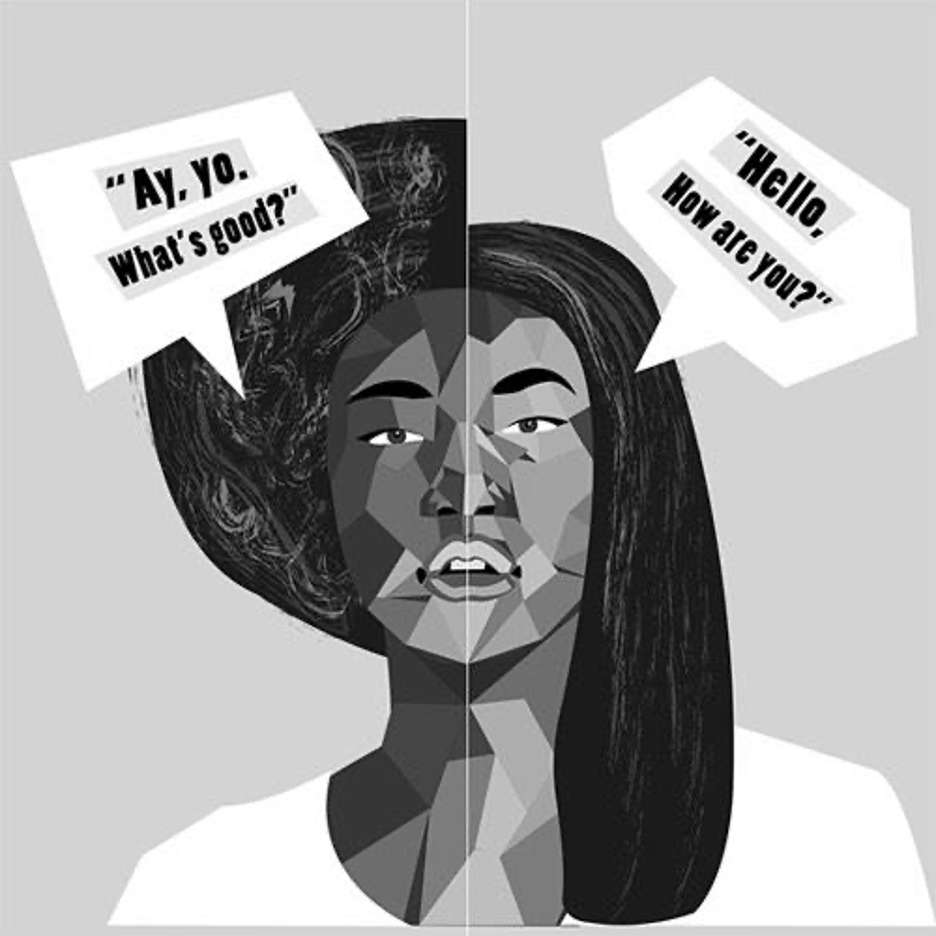
Code Switching
Code Switch: Behavioral Changes to Survive in the Dominant Culture
Author(s): Mariame Fofana, MD & Kari Haley, MD
Editor: Marquita S. Norman, MD, MBA
Definition(s) of Terms
Starting with a common understanding of key words, phrases, and potentially misunderstood related terms in DEI discussions helps ensure that all participants feel informed and welcome to participate in the discussion. Some terms have multiple definitions provided to help highlight nuances in the definitions.
Many people of color in this country code-switch to be more accepted in various environments. This is done to provide comfort to the “ dominant culture” at the expense of sacrificing socio-cultural preferences. The aim of this section is to discuss code switching and how it impacts the experience of people of color in medicine.
Code switch:
Linguistic definition: using two or more languages or dialects in a single interaction or conversation (1).
Sociological definition: According to McCluney et al (2), Code switching involves adjusting one’s speech, appearance, behavior, and expression in ways that will optimize the comfort of others in exchange for fair treatment, quality service, and employment opportunities.
Dominant culture: a cultural practice that is dominant within a particular political, social or economic entity, in which multiple cultures co-exist. It may refer to a language, religion/ritual, social value and/or social custom (3).Synonyms/Related Terms
This section highlights the definitions of other words that may be used in discussion of this topic. Sometimes these words can be used interchangeably with the terms defined above, and sometimes they may have been used interchangeably historically, but have distinct meanings in DEI conversations that it is helpful to recognize.
Code mixing: a term used interchangeably with the linguistic definition of code switching. Defined as the hybridization of two languages or linguistic elements (4).
Scaling This Resource: Recommended Use
As many users may have varying amounts of time to present this material, the authors have recommended which resources they would use with different timeframes for the presentation.
1 minute: I think this would be challenging for this concept. A brief history and example in picture form.
10 minutes: Introduction to the subject with the summary, play TED talk video.
30 minutes: Introduction to the subject with the summary, play TED talk or Huffpost video, Role playing.
Discussion/Background
This section provides an overview of this topic so that an educator who is not deeply familiar with it can understand the basic concepts in enough detail to introduce and facilitate a discussion on the topic. This introduction covers the importance of this topic as well as relevant historical background.
Code switching is defined as using two or more languages or dialects (linguistic codes) in a single interaction or conversation. It was a term coined in linguistics in the 20th century to define how individuals adapt to language differences. It is a term that originated in the linguistic field and was first described in the early 20th century but not fully explored until the mid 1900s. It has been studied in numerous fields with a focus on the actual structural makeup, however a focus on the sociocultural study of the term was focused more so in the 1980s and 1990s where the practice of code switching in particular settings rather than a structural concept was performed.
For the purposes of this work, code switching is defined by its more sociocultural definition which encompasses concepts such as dialect, mannerisms and accents. In a more broad perspective, the term code-switching has changed over the years to encompass both the language (whether various dialects or English vernacular) and behavioral changes that people of color have to make to adapt to various environments. The meaning behind the term has evolved to encompass more sociological factors and definition over time. Although it allows many individuals to maneuver various environments, it’s important to know the social implications of code switching for people of color, sociocultural sacrifices that individuals have to make, and ultimately, the challenges faced in medicine. Being aware of the impact of code switching, can allow for more diversity and inclusivity in medicine.
For many people of color in the United States, the use of code switching stems from the inferiority of cultural standards, languages, beliefs that are different from the dominant white American culture and the need to adapt and effectively communicate and navigate different environments to progress in medicine. Deviations or rather dialects of American English tend to be deemed as inferior or improper. When spoken in various settings especially by a person of color, misrepresentations of being uncivilized or uneducated exist. “ The speakers of these subordinate dialects are rejected on the basis of stereotyped expectations, language, cultural factors and so on” (5). This negatively affects acquisition of jobs in preferred professions, economic growth, and ultimately, further prejudice by the mainstream society. For Black individuals to adapt to specific environments, “ the social situation and audience determine which variety or dialect is used. Such switching appears to be unconscious and reflexive” (5). Hence, code switching. Other portrayals of changing language or rather expression of language to be more acceptable in the “ dominant” culture is by hiding your accent or using a more conventional “professional” or “ intelligent” tone. Although these changes are temporary, they force an individual to abandon an aspect of their identity. This is exemplified in an article written by Megan Zullo, “ Code- switching is more than changing some words that you use and slightly altering your accent. I am abandoning a piece of my identity” (6).
Code- switching also entails changing your physical appearance to be more “presentable.” Many may ask, what is considered more presentable? Anything that is attributable to whiteness. For example, straight or wavy hair, wearing suits, wearing neutral colors, “conservative” jewelry. Any variations from this, especially in medicine can be deemed as unprofessional or unacceptable. Specific examples of unprofessional presentations are curly hair, afros, braids, locs, body art, hijab or any form of cultural or religious head garb. Many of these are integral to the cultural identity of specific minority groups in this country and unfortunately, they often change their appearance to avoid discrimination and scrutiny in the workplace.
Furthermore, many individuals of color have to spend time learning and researching interests specific to the dominant culture to further assimilation. This is done to both become more acceptable and provide comfort to others. Dr. Italo Brown discusses his experience as both a person of color and more specifically, an underrepresented minority physician in, Code- Switching as an EM Survival Tactic, “ There was a period in my career where I paid special attention to NHL hockey. As a Black man from California, hockey was never on my radar, but I knew many of my colleagues followed the sport closely… the desire to preserve my team’s comfort dy-namic outweighed the desire to uphold my own identity” (7). Dr. Italo Brown’s experience is similar to the experiences of many underrepresented minorities in medicine. Sacrificing this aspect of your identity can be exhausting and further perpetuates barriers underrepresented minorities face in medicine.
Ultimately, many people of color and more specifically, underrepresented minorities in medicine have to code switch to both assimilate and provide comfort to the dominant culture in medicine. Awareness of this can help allow for better support and inclusivity in medicine.
Quantitative Analysis/Statistics of note
This section highlights the objective data available for this topic, which can be helpful to include to balance qualitative or persuasive analysis or to help define a starting point for discussion.
Close to 50% of college graduates feel the need to change the way they speak when they are around people of other races from Pew Research Center (8).
Black and Hispanic Americans are more likely than their whiter counterparts (48% and 42% consecutively) to say that they at least sometimes feel the need to change the need to change the way they express themselves when they are around people of different racial and eithnic background from Pew Research Center (8).
Among black adults, 48% of those with at least a four-year college degree say they often or sometimes feel the need to code-switch, compared with 37% of those who do not have a college degree. Among Hispanic and white adults, there are no significant differences by education (8).
Slide Presentation or Images
Images and graphical representations in presentations can clarify concepts and enhance interest. Please cite the sources of these images appropriately if you use them in your presentation, found in the last section of this page. We purposefully avoided providing complete slide decks in this curriculum, and instead opted to offer easy building blocks for a great personalized presentation regardless of the format.

Citation: 9

Citation: 10

Citation: 11

Citation: 12
Role-playing Scenario
Role-playing scenarios can enhance investment and participation. Always consider psychological safety when asking participants to engage in any role-playing activity to avoid potential adverse effects. We highly recommend a discussion for each group to agree on ground rules of respectful learning prior to engaging in any role-playing scenarios (embrace ambiguity, commit to learning together, listen actively, create a brave space, suspend judgment, etc.). It is reasonable to review these ground rules prior to each role-playing discussion.
Scenario 1: You are on an off service rotation and have gotten to know one of the other residents fairly well. You have been able to bond over a few difficult cases and have been casual with each other. You have appreciated their positivity and encouragement throughout the rotation. One day a new attending comes on service and you are rounding. They make comments on your fellow residents’ hair, dialect and use of medial lexicon after each of their presentations. They do not make the same comments for you. The next day, you notice your friend has changed their appearance and how they match the cadence of your attending’s speech, and you notice at the day’s end their positivity that was there before is significantly dampened.
- Comment on the observations you have made of your fellow resident
- How would you approach your fellow resident?
- Would you approach your new attending? Why or why not?
- Discuss if you have ever witnessed this happen in the past.
Scenario 2: You are a female junior faculty in a large academic group where there are only 2 other female faculty who have been part of the group for many years before you joined. You joined the group after your ultrasound fellowship and have a lot of new ideas to bring to the group. After attending a few faculty meet and greets, as well as meetings, you have noticed that others do not seem interested in some of the ultrasound changes you have made. You want to push the group to obtain multiple views and label any point of care ultrasounds they obtain. After a meeting, one of your male colleagues approaches you, slaps you on the back and says “Hey, we all think you’re great, but before you were here, George was the ultrasound champion, and he would usually just take care of that stuff for us.” He winks, and walks off.
Feeling uncomfortable about this interaction and not sure what to do, you get lunch with the other female faculty the next week. You talk to them about the situation. They say, “You know, it is much easier to just go with the flow here. Don’t make too many waves so soon. You came off as a little pushy during that meeting, and we just don’t want you to get a reputation as an aggressive female. No one in the group will respect you as a female if you are too aggressive.” They suggest you continue George’s workload, learn to make small talk about subjects like home beer brewing and road bikes, and to change your tone when asking for something to a more submissive or passive position. They think you will find success with these changes.
- Discuss the role of a dominant culture within this physician group. Who makes up the dominant culture, and how would you define it? Who is part of the nondominant culture?
- What changes has the nondominant culture made or recommend to “fit in”? How would this make you feel if you were part of the nondominant culture?
- Discuss situations where you may have been part of either the dominant or nondominant culture within a group. What changes in your personality, speech, dress, etc. did you make to accommodate the group? How did that make you feel then? How does it make you feel now?
Barriers/Challenges/Controversies
This section should help the facilitator anticipate any questions, naysayers, rebuttals, or other feedback they may encounter when presenting the topic and allow preparation with thoughtful responses. Facilitators may experience concerns about their personal ability to present a specific DEI topic (ie a white facilitator presenting on anti-racism or minority tax), and this section may address some of those tensions.
Barriers:
- Recognizing when another person may be code-switching (person may not even be aware themselves)
- Others not wanting to be recognized for code-switching
Challenges:
- Creating an environment where the subject can be safely discussed. If we are not talking about the need for people of color to code-switch within our own environment, we are in essence giving the perspective that it is expected to succeed. If we are able to create discussion, in a way that is safe and non judgemental, we have the opportunity to look at our own practices and biases that contribute to the feelings of people of color and the need to practice code-switching. Additionally, part of code switching itself is a way of adaptation to a “dominant” culture and so emphasizing a safe space for discussion is of utmost importance if true understanding of the perspective of others is desired.
Controversies:
- Code switching can be useful
- As previously discussed, code switching is used by a non-dominant population as a tool to “fit in” or even succeed in the dominant culture. The benefit is the ability to succeed in settings and adapt to an environment where one’s normal speech, dress, culture may not be accepted or thought of as “less than”. From a certain perspective, this could be viewed that the ability to code switch is useful for academic/professional success, or even societal acceptance.
- As language tool for teaching english in foreign language classrooms
- In the world of linguistics, where code-switching has also been described, use of code-switching can be used by teachers to help facilitate learning of a second language. In a study by Bhatti (13) based on observations in classrooms where english is taught as a foreign language in Pakistan, they describe use of jargon or primary language to help facilitate the teaching of english. English as used primarily in the classrooms, but they found that teachers would use code switching to help connect with students, clarify points and help use to facilitate their student’s learning. While this use of code-switching does not necessarily relate to the sociocultural definition more relevant to the discussion, it could be used as a conversation piece to how the practice of altering our language could be used for positive outcomes.
Opportunities
Sometimes DEI topics can present depressing history and statistics. This section highlights glimmers of hope for the future: exciting projects, areas of study inspired by the topic, or even ironic twists where progress has emerged or may be anticipated in the future.
As the concept of code switching becomes more commonly known, there has been work to expand diversity training and both equitable and inclusive practices. The charge to create an inclusive environment has brought new ideas to workplaces in how to make an environment feel comfortable for all.
- Creating an inclusive environment.
- With the recognition of the importance of diversity in our workplace and beyond, many groups are working on ways to create a more inclusive space
- The sharing of ideas of creating inclusive environments will hopefully lead to an expanded “dominant culture” where socio and linguistic parameters are more inclusive.
- Emergency medicine sees an extremely diverse patient population. It is a speciality where promoting diversity and inclusion is beneficial to the variety of patients that we serve. This includes creating an environment where both patients and staff can feel safe to be their authentic selves.
- There have been academic institutions that have published courses on creating inclusive environments in emergency medicine
- National organizations have had some best practice recommendations
- Best Practices for Creating a Diverse and Inclusive Residency Program: Recruitment and Retention of Women in Emergency Medicine (ADIEM Sponsored) (saem.org) (17)
- While this video is targeted talk to women, some of the strategies are more widely applicable to creating a practice environment where all can feel welcome and valued. It also gives examples of ways to promote a data driven approach to show that you are continually looking at the group makeup and qualities.
- Part of inclusion is showing value in all represented in the recruitment process so involving women, people of color, and underrepresented minorities in recruitment efforts.
- Support all staff in professional development with funds or encouragement in professional medicine groups and conferences
- Highlight and amplify accomplishments and nominations for leadership roles
- Think of sponsorship as a strategy vs mentorship where departmental leaders encourage and promote underrepresented minorities within emergency medicine as leaders
- Create a blind audit process that looks at pay and promotion
- Advocate for a confidential liaison for bias related issues
- While this video is targeted talk to women, some of the strategies are more widely applicable to creating a practice environment where all can feel welcome and valued. It also gives examples of ways to promote a data driven approach to show that you are continually looking at the group makeup and qualities.
- Best Practices for Creating a Diverse and Inclusive Residency Program: Recruitment and Retention of Women in Emergency Medicine (ADIEM Sponsored) (saem.org) (17)
Journal Club Article links
A journal club facilitator can access several salient publications on this topic below. Alternatively, an article can be distributed ahead of a presentation to prompt discussion or to provide a common background of understanding. Descriptions and links to articles are provided.
Diversity Matters: Code-Switching as an EM Survival Tactic : Emergency Medicine News (lww.com)
- Description: This article (7) describes how code-switching is present in emergency medicine for physicians who are underrepresented minorities.
- Importance/Use: Recognition of the “culture” of emergency medicine and how the speciality has room to grow. Can use this article to reflect on your departmental culture and hear voices from underrepresented minorities.
- Description: This article (18) reflects on the experience of a female black physician and gives an inside view on the practice of code switching.
- Importance/Use: Use to highlight the stories of underrepresented minorities in medicine, and to offer a different perspective on how the actions of others affect them, as well as how they view themselves.
Discussion Questions
The questions below could start a meaningful discussion in a group of EM physicians on this topic. Consider brainstorming follow-up questions as well.
- How does the culture of emergency medicine contribute to the practice of code switching?
- Within a clinical rotation?
- For outside learners
- Within a physician group and their practice?
- Colleague to colleague
- Administrative team to physician group
- Within profession/social circles?
- Within a clinical rotation?
- Think of a time when you have used code switching.
- How did it make you feel?
- What if you needed to do that every day at work, or in public settings?
- What if it seemed required in order to succeed in your work?
- What if it seemed required in order for you to not be targeted in public?
- What tools can we use as emergency physicians to foster a culture where code switching is not necessary?
- How will that impact our colleagues?
- How will it impact patient care?
Summary/Take-home Themes
The authors summarize their key points for this topic below. This could be useful to create a presentation closing.
- Code switching is a real practice that many people of color use to be accepted into the greater group as well as advance within their profession.
- Code switching can be detrimental to a person of color as it can cause loss of self or extra mental burden
- This topic can be difficult to identify
Relevant Quotations
Meaningful and relevant quotations (appropriately attributed) can be used to enhance presentations on this topic.
“It is a peculiar sensation, this double-consciousness, this sense of always looking at one’s self through the eyes of others, of measuring one’s soul by the tape of a world that looks on in amused contempt and pity. One ever feels his two-ness, an American, a Negro; two souls, two thoughts, two unreconciled strivings; two warring ideals in one dark body, whose dogged strength alone keeps it from being torn asunder” (19). - Du Bois WEB. The Souls of Black Folk. Chicago: A.G. McClurg, 1903.
Community Resource Links
Below are links to educational resources or supportive programs in the community that are working on this topic.
- NPR has a podcast dedicated to exploring how race affects our society and tells stories of real people and how they navigate their race in the world today (20). There are multiple episodes that talk directly about the practice of code-switching.
Video Links
Below are links to videos that do an excellent job of explaining or discussing this topic. Short clips could be used during a presentation to spark discussion, or links can be assigned as pre-work or sent out for further reflection after a presentation.
The Cost of Code Switching | Chandra Arthur | TEDxOrlando - YouTube
- A TED talk that highlights the social definition of code switching, as well as giving examples from the speaker’s own life that draws attention to the reality of the subject (21). She highlights how learning to code switch, the practice of thinking about it, and how it affects the individual but also how this affects society as well.
What Is Code-Switching? | Between The Lines - YouTube
- Video produced by “Huffpost” that seeks to define code switching and give examples of how it is intertwined with racism in the United States (22).
Quiz Questions/Answers
Possible questions and an answer key are provided below. These can be useful to document effectiveness in learning and knowledge gained but can also be useful to help learners identify that they may not actually know everything about a DEI topic, even if they have participated in presentations on it previously.
- Define code-switching.
- How is code switching used in modern society?
- In what ways do underrepresented minorities in emergency medicine use code switching?
Answer Key
- Using two or more languages or dialects (linguistic codes) in a single interaction or conversation.
- As a way for a minority to communicate with the “dominant” culture.
- Discussion of sports, change of hair or clothing, dialect of the spoken word, changes in behavior when interacting with colleagues or leadership, changes in patient care style when interacting with other staff
Call to Action Prompt
Below is a statement that inspires participants to commit to meaningful action related to this topic in their own lives. This could be used to prompt reflection, discussion, or could be used in a presentation closing.
As we learn more about code-switching and how it impacts the lives of those required to adapt themselves to the “dominant” culture, we should seek to build a truly diverse community where we are inclusive of all and celebrate differences. We will only become better colleagues, mentors, and clinicians as we promote inclusivity and recognize the challenges we place on others when they feel the need to code-switch to survive the environment we create.
Reference
All references mentioned in the above sections are cited sequentially here.
- The Editors of Encyclopedia Britannica. “Anthropological Linguistics,” n.d. https://www.britannica.com/science/computational-linguistics.
- McCluney et al. “The Costs of Code-Switching.” Harvard Business Review, The Big Ideas/ Advancing Black Leaders, November 15, 2019. https://hbr.org/2019/11/the-costs-of-codeswitching.
- Cooks- Campbell, Allaya. “ What does “Dominant Culture” mean in the workplace?” BetterUp. June 3, 2021. https://www.betterup.com/blog/dominant-culture
- Kester, Ellen. “ Code- Switching and Code- Mixing- What You Need to Know.” BILINGUISTICS, Better Speech Therapy. https://bilinguistics.com/code-switching-and-code-mixing/
- Toliver-Weddington, Gloria. “The Scope of Black English.” Journal of Black Studies 4, no. 2 (December 1973): 107–14. https://doi.org/10.1177/002193477300400201.
- Megan Zullo. “ Why do I have to Change how I talk to sound Professional.” Youth Communication. 2022. https://youthcomm.org/story/why-do-i-have-to-change-how-i-talk-to-sound-professional/
- Brown, Italo M. “Diversity Matters:Code-Switching as an EM Survival Tactic.” Emergency Medicine News 43, no. 1 (January 1, 2021): 7. https://doi.org/10.1097/01.EEM.0000731740.47326.45.
- Dunn, Amina. “Younger, College-Educated Black Americans Are Most Likely to Feel Need to ‘Code-Switch,’” September 24, 2019. https://www.pewresearch.org/fact-tank/2019/09/24/younger-college-educated-black-americans-are-most-likely-to-feel-need-to-code-switch/
- Gonzalez, Jennifer. “ Know Your Terms: Code Switching.” Cult of Pedagogy.2022. https://www.cultofpedagogy.com/code-switching/
- Manning, Nicole. “ How “ Code Switching” Affects Our Lives.” MCSM RAMPAGE. 2022. https://mcsmrampage.com/2022/01/how-code-switching-impacts-our-lives/
- Dorsey, Amber. “ 17 Times “ Black-ish” Kept It Real.” Buzzfeed. 2015. https://www.buzzfeed.com/amberdorsey/17-times-blackish-nailed-modern-black-parenting
- Robbins, Tressa. “ Code- Switching in the Workplace: Being Authentic and Building Resilience.” Burrelles, Media Data Beyond Automation. February 23, 2021. https://burrelles.com/code-switching-in-the-workplace-being-authentic-and-building-resilience/
- Bhatti, Aisha, Sarimah Shamsudin, and Seriaznita Binti Mat Said. “Code-Switching: A Useful Foreign Language Teaching Tool in EFL Classrooms.” English Language Teaching 11, no. 6 (May 14, 2018): 93. https://doi.org/10.5539/elt.v11n6p93.
- St. Catherine University. “ Strategies to Create a Culture of Inclusion in the Workplace.” St. Catherine University. August 5, 2021. https://www.stkate.edu/academics/women-in-leadership-degrees/strategies-create-culture-inclusion-workplace
- Bhattia, Sue. “ Creating A More Diverse, Inclusive Workplace.” Forbes, Forbes Business Development Council. June 26, 2020. https://www.forbes.com/sites/forbesbusinessdevelopmentcouncil/2020/06/26/creating-a-more-diverse-inclusive-workplace/?sh=5170fbf83e4f
- Brown Emergency Medicine/ Brown Physicians Incorporated. “ Creating An Inclusive Environment: A Requisite For Academic Institutions.” Brown Alpert Medical School. March 3, 2020. https://cme-learning.brown.edu/EM-BP-20
- Pierce et al. “Best Practices for Creating a Diverse and Inclusive Residency Program: Recruitment and Retention of Women in Emergency Medicine ( ADIEM Sponsored)” Society for Academic Emergency Medicine. August 3, 2020. https://www.saem.org/detail-pages/media/best-practices-for-creating-a-diverse-and-inclusive-residency-program-recruitment-and-retention-of-women-in-emergency-medicine-adiem-sponsored-e10a2a
- Blanchard, Anita K. “Code Switch.” New England Journal of Medicine 384, no. 23 (June 10, 2021): e87. https://doi.org/10.1056/NEJMpv2107029.
- Du Bois, W.E.B. The Souls of Black Folk; Essays and Sketches. Chicago, A. G. McClurg, 1903. Basic Afro- American Reprint Library. New York : Johnson Reprint Corp, 1968.
- npr. “Code Switch,” n.d.
- Arthur, Chandra. “ The Cost of Code Switching.” TEDxOrlando, Youtube. August 22, 2017. https://www.youtube.com/watch?v=Bo3hRq2RnNI
- Huff Post. What Is Code-Switching? | Between The Lines, n.d. https://www.youtube.com/watch?v=QNbdn0yuUw8.
- Block, Aaron. “Code-Switching Isn’t Always Bad,” November 3, 2013. https://scienceleadership.org/blog/Code-switching_Isn-t_Always_Bad
- Chellapilla, Varshini. “How Code-Switching Impacts the Lives of Black Students at Penn State.” The Daily Collegian (blog), May 8, 2020. https://www.collegian.psu.edu/news/campus/how-code-switching-impacts-the-lives-of-black-students-at-penn-state/article_0f83d56e-90e3-11ea-80f3-a3cbe72fdf11.html
- Demby, Gene. “How Code-Switching Explains The World.” NPR (blog), April 8, 2013. https://www.npr.org/sections/codeswitch/2013/04/08/176064688/how-code-switching-explains-the-world
- Gray, Aysa. “The Bias of ‘Professionalism’ Standards,” 2019. https://doi.org/10.48558/TDWC-4756
- Greene, Deric M., and Felicia R. Walker. “Recommendations to Public Speaking Instructors for the Negotiation of Code-Switching Practices among Black English-Speaking African American Students.” The Journal of Negro Education 73, no. 4 (2004): 435. https://doi.org/10.2307/4129627
- Harris, Ida. “Code-Switching Is Not Trying to Fit in to White Culture, It’s Surviving It.” Yes! Solutions Journalism, December 17, 2019. https://www.yesmagazine.org/opinion/2019/12/17/culture-code-switching
- Morris, Natalie. “People of Colour Have to ‘Code-Switch’ to Fit in with White Norms,” March 3, 2020. People of colour have to ‘code-switch’ to fit in with white norms.
